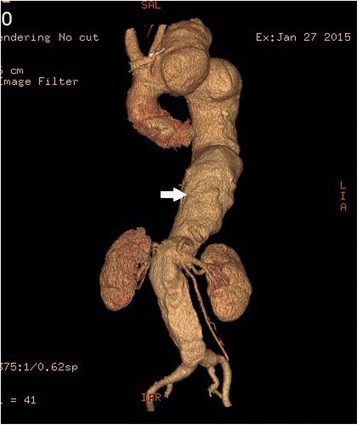Ortner's syndrome presenting as thoracic aortic aneurysm mimicking thoracic malignancy: a case report
- PMID: 26104067
- PMCID: PMC4481080
- DOI: 10.1186/s13256-015-0629-1
Ortner's syndrome presenting as thoracic aortic aneurysm mimicking thoracic malignancy: a case report
Abstract
Introduction: Ortner's syndrome is defined as left recurrent laryngeal nerve palsy caused by a cardiovascular pathology. Here we report the case of a 68-year-old man who presented to our hospital with hoarseness, whose initial chest imaging mimicked a thoracic neoplastic process with left pleural effusion. The final diagnosis was Ortner's syndrome due to the silent rupture of a thoracoabdominal aortic aneurysm. Diagnostic thoracentesis, before computed tomography, in resource-poor settings, may have resulted in an adverse outcome in our case.
Case presentation: A 68-year-old Sri Lankan man was referred to us by an otolaryngologist for further evaluation of a suspected thoracic malignancy. His presenting symptom was hoarseness of three months duration. He had essential hypertension for the last four years and had a history of 25 pack-years of cigarettes smoking. His chest X-ray showed a left-sided mediastinal mass with mild to moderate pleural effusion. An ultrasound appeared to show an encysted pleural fluid collection. However, we proceeded with computed tomography before diagnostic thoracentesis. The diagnosis of Ortner's syndrome was made after the computed tomography due to the silent rupture of his thoracoabdominal aortic aneurysm.
Conclusions: Hoarseness due to left recurrent laryngeal nerve palsy can be the presenting symptom of cardiovascular pathologies, Ortner's syndrome. Silent rupture of thoracic aortic aneurysms can mimic that of thoracic malignancy, which is reported in literature. We illustrate the importance of a high degree of suspicion of cardiovascular pathology in order to avoid an adverse outcome following diagnostic thoracentesis.
Figures



Similar articles
-
Hoarseness as imminent symptom of aortic aneurysm rupture (Ortner's syndrome).Int Angiol. 2006 Jun;25(2):231-3. Int Angiol. 2006. PMID: 16763545
-
Ortner's syndrome secondary to thoracic aortic aneurysm: a case series.J Cardiothorac Surg. 2022 Oct 20;17(1):270. doi: 10.1186/s13019-022-02023-1. J Cardiothorac Surg. 2022. PMID: 36266693 Free PMC article.
-
Ortner's syndrome: a centenary review of unilateral recurrent laryngeal nerve palsy secondary to cardiothoracic disease.J Laryngol Otol. 1997 Sep;111(9):869-71. doi: 10.1017/s0022215100138848. J Laryngol Otol. 1997. PMID: 9373557
-
Ortner's syndrome: a case report and review of the literature.BMJ Case Rep. 2014 Jul 17;2014:bcr2013202900. doi: 10.1136/bcr-2013-202900. BMJ Case Rep. 2014. PMID: 25035442 Free PMC article. Review.
-
Endovascular management of hoarseness due to a thoracic aneurysm: case report and review of the literature.Vasc Endovascular Surg. 2009 Apr-May;43(2):195-8. doi: 10.1177/1538574408324616. Epub 2008 Sep 30. Vasc Endovascular Surg. 2009. PMID: 18826980 Review.
Cited by
-
Ortner's syndrome: A systematic review of presentation, diagnosis and management.Intractable Rare Dis Res. 2023 Aug;12(3):141-147. doi: 10.5582/irdr.2023.01047. Intractable Rare Dis Res. 2023. PMID: 37662622 Free PMC article. Review.
-
A Huge and Asymptomatic Aortic Aneurysm Mimicking Intra-Cardiac Tumor.Acta Cardiol Sin. 2020 Sep;36(5):523-524. doi: 10.6515/ACS.202009_36(5).20200626A. Acta Cardiol Sin. 2020. PMID: 32952364 Free PMC article. No abstract available.
-
Cardiovocal Syndrome Secondary to Thoracic Aortic Aneurysm: An Old Sign Revisited.Cureus. 2020 Aug 27;12(8):e10087. doi: 10.7759/cureus.10087. Cureus. 2020. PMID: 33005510 Free PMC article.
References
-
- Hiratzka LF, Bakris GL, Beckman JA, Bersin RM, Carr VF, Casey DE, Jr, et al. 2010 ACCF/AHA/AATS/ACR/ASA/SCA/SCAI/SIR/STS/SVM guidelines for the diagnosis and management of patients with thoracic aortic disease: a report of the American College of Cardiology Foundation/American Heart Association Task Force on Practice Guidelines, American Association for Thoracic Surgery, American College of Radiology, American Stroke Association, Society of Cardiovascular Anesthesiologists, Society for Cardiovascular Angiography and Interventions, Society of Interventional Radiology, Society of Thoracic Surgeons, and Society for Vascular Medicine. Circulation. 2010;121(13):e266–369. doi: 10.1161/CIR.0b013e3181d4739e. - DOI - PubMed
Publication types
MeSH terms
LinkOut - more resources
Full Text Sources
Other Literature Sources

